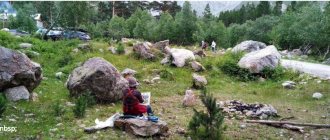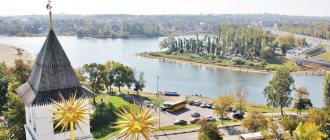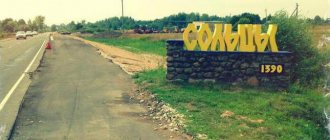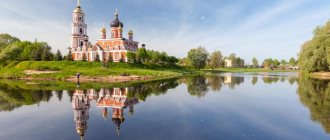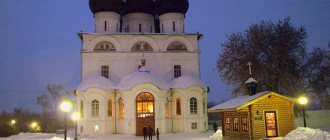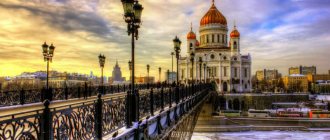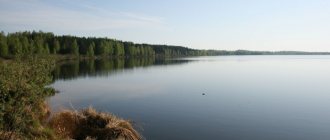The Novgorod region is a territory known since ancient times with beautiful natural places and stunning monuments of religious architecture. The history of this land goes back many centuries. From here the Rurik family began its march across Rus', and Novgorod the Great was founded here.
The independence of the ancient lands of the Novgorod region lasted until 1570, when Ivan the Terrible conquered Novgorod and the lands belonging to him and annexed them to the Moscow Principality.
Iversky Valdai Monastery
The real Orthodox pearl of the Novgorod region is the Iversky Svyatoozersky Borogoditsky Valdai Monastery, founded by Patriarch Nikon in 1654 in a stunningly beautiful place - one of the islands of Lake Valdai. The Great Patriarch was attracted not only by the beauty of these places, but also by numerous tales and legends about the miracles that happened here. According to Nikon's plan, the Valdai Monastery was to become the center of spiritual enlightenment in Rus' and was built in the image of the Iveron Monastery on Mount Athos.
The Iversky Monastery quickly became rich and influential; it owned several surrounding villages, but from the beginning of the 18th century. the affairs of the monastery fell into disrepair. After the revolution, the monastery was transformed in 1919 into the Iverskaya labor artel with 200 hectares of gardens, vegetable gardens and other lands. In 1927, the artel was abolished and the monastic community was liquidated. The monastery buildings housed museums, workshops, a forest school for children with tuberculosis, a recreation center, etc.
In 1991, the monastery was returned to the church, and the restoration of this holy place began; to date, it has been completely restored. The most famous beautiful buildings of the monastery are the Church of St. Philip of Moscow (1653), the Assumption Iveron Cathedral (1656)
Historical places
German Memorial Cemetery
Coordinates: 57.716446, 31.972604 How to get there: by personal transport from the village of Korpovo 2 min.
More than 30 thousand soldiers are buried in the German cemetery in the village of Korpovo. Their remains are brought here from all over the region.
Mass death sites are carved on one of the stones. The cemetery was designed and built by the Germans, and order is maintained at their expense.
They say that the paths are cleared here, even when the entire village is waist-deep in snow.
Travel Palace of Alexander I
Address: Korostyn village, st. Ozernaya How to get there: bus or car, 1 hour from Veliky Novgorod Opening hours: under restoration
The palace is a two-story mansion decorated with columns. It was built by the architect Vasily Stasov for Alexander I on the shore of Lake Ilmen.
An orchard with trees from the times of Catherine II has been preserved here.
At the moment, the estate is under restoration, which will last until the end of 2022. After which it will house a clay toy museum dedicated to the Ilmen Glint. This is a 15-meter cliff on the shore of the lake, which is a protected natural monument.
Vitoslavlitsy
Coordinates: 58° 31′ 32.0513″, 31° 16′ 27.0941″ Phone: 8(1627) 9-21-50 Website: novgorodmuseum.ru Opening hours: May-August 10:00-20:00, October - March 10:00-16:00, September and April 10:00-18:00 Cost: children under 16 years old - free, students - 120 rubles, adults - 170 rubles; group excursions from 640 rub. How to get there: bus, personal transport; from Veliky Novgorod 1.5 hours and 20 minutes.
The first exhibit of the museum of wooden architecture was the Church of the Assumption of the Virgin Mary (1595). She was transported here from the village. Kuritsko in 1964.
Today, huts, chapels and churches form real streets. There is even a stable and a goat shed. Here they show how animals are cared for, from cleaning and milking to shoeing.
Inside the exhibits there are exhibitions with interactive elements. Visitors can here:
- visit one of 6 exhibitions introducing peasant life;
- watch the craftsmen at work;
- take part in games and celebrations;
- take a master class on felting wool products.
House-Museum of Nekrasov in Chudovo
Address: Chudovo, st. Kosinova, 1 Phone: 8(1665) 5-42-67 Website: novgorodmuseum.ru Opening hours: Tue-Sun 10:00-17:00 Cost: children under 16 years old - free, students - 60 rubles, adults - 120 rub., excursions from 320 rub.
Nikolai Alekseevich came to Chudovo to take a break from the worries of the city, to hunt, and to communicate with people. It was here that the poet met his last love and wife.
Here the “Monster Cycle” of 11 works was born, work began on “Contemporaries” and the 4th chapter of the poem “Who Lives Well in Rus'” was written.
At one time, many of the poet’s friends visited the estate: G. I. Uspensky, M. E. Saltykov-Shchedrin, N. K. Mikhailovsky, A. N. Pleshcheev.
The first exhibition was opened in 1971. Today here you can see interiors from Nekrasov’s times and personal belongings of the poet’s family.
House-Museum of G. I. Uspensky
Address: Syabrenitsy village, st. Radishcheva, 73 Phone: 8 (1665) 4-16-94 Website: novgorodmuseum.ru Opening hours: Mon-Sun 10:00-18:00, Tue, Wed - weekends Cost: children under 16 years old - free, students - 60 RUB, adults - 120 RUB, excursion from 320 RUB. How to get there: bus or personal transport, 10 minutes from Chudovo.
The writer lived with his family in the village of Seryabrenitsy for a year. Later, it was here that the only museum in Russia was opened in his honor. The following works were written in this house:
- "Power of the Earth";
- "Quarter Horse";
- “Petka’s career”;
- "Live numbers".
Museum-Reserve of A.V. Suvorov
Address: s. Konchansko-Suvorovskoye, st. Central, 19 Phone: 8(1664) 9-85-33 Website: novgorodmuseum.ru Opening hours: Mon-Sun 10:00-16:00 (autumn-winter), 10:00-17:00 (spring-summer) ; Tue - closed Cost: children under 16 years old - free, students - 120 rubles, adults - 240 rubles, excursion from 320 rubles. How to get there: bus or car, 3 hours from Veliky Novgorod.
Of the Suvorov family's possessions, only the house in the village has been preserved in its original form. Konchanskoye, which was the place of exile of the commander at the end of the 18th century. The museum opened in 1942. During its existence:
- reconstructed a summer house on Mount Dubikha;
- We restored the Church of Alexander Nevsky and opened the diorama “Alpine Campaign of A.V. Suvorov” in it.
- outbuildings were restored.
Today the museum occupies an area of 4.5 hectares, among its exhibits are original things of the commander, furniture of that era; works of art that tell the story of exile.
Museum "Slavic Village of the 10th Century"
Address: Lyubytino village Telephone: 8(1668) 6-17-93 Website: lubturism.ru Opening hours: Tue-Sat 09:00-18:00 (April-September), 10:00-17:00 (October- March); Mon, Sun - weekends Cost: preschoolers - free, schoolchildren and students - 10 rubles, adults - 50 rubles. How to get there: by car or bus; 2.5 hours from Veliky Novgorod
Due to the peculiarities of the landscape, the area where the museum is located is called “Novgorod Switzerland” and “Pyramids of the North”. Lakes, waterfalls and mounds are what awaits tourists here.
The museum itself is stylized as a Slavic settlement of the 9th-10th centuries. The buildings on its territory are copies of structures of that time.
When working on the exhibits, only tools available to our ancestors were used. Anyone can learn to use them here.
A master class on clay modeling is also held for visitors.
Lake Velje
One of the most beautiful places in the Novgorod region is the lake of glacial origin Velye. It is located among centuries-old forests, the same age as The Tale of Bygone Years, on the territory of the Valdai National Park. This is one of the largest and most beautiful lakes in Russia - its length from north to south is about 25 km.
The lake is framed by high hilly shores, indented by sandy bays of various sizes, and about 200 picturesque islands of various sizes and origins are scattered on its water surface.
Novgorod Museum-Reserve
The Novgorod Museum-Reserve is one of the most interesting and oldest museum centers in Russia. The story began in 1865, but then only the Museum of Antiquities was created, which later turned into the Novgorod Museum-Reserve. Initially, the museum’s balance sheet included 110 architectural monuments of the 12th – 19th centuries, and 14 of them surprised with unique monumental painting.
The collection of the Novgorod State Museum-Reserve is one of the richest. The total number of exhibits exceeds 800 thousand. The following valuable exhibits are presented here:
- Archaeological sites.
- Numismatics.
- Sphragistics.
- Heraldry.
- Medieval handwritten and early printed books.
- Written documents and princely charters.
- Russian painting.
- Graphics and sculptures.
- Works of decorative and applied art.
- Samples of ancient Russian sewing.
The rich exposition will make a special impression.
Nikolo-Vyazhishchi Monastery
Another famous and beautiful place in the Novgorod region is the Nikolo-Vyazhishchi Monastery (XIV century), located in the village of Vyazhishchi. This is an amazingly beautiful architectural religious ensemble, built on the river of the same name. The elegance and integrity of the image of the monastery, abundantly decorated with colored tiles - the rightful pride of the inhabitants, harmoniously fits into the surrounding virgin and beautiful landscapes.
To date, of all the buildings of the monastery, only the refectory with the churches of the Ascension and St. John the Evangelist (1694-1698), St. Nicholas Cathedral (1681-1683) and one residential building of strict architecture have been preserved.
Beautiful tiles, which have become popular elements of the exterior decoration of buildings in the Novgorod region since the 16th century, give the buildings of this holy place a special charm. It is not known for certain where the tiles for the Vyazhishchi Monastery were made; according to researchers of its history, they were specially brought from Moscow.
Embankment of Veliky Novgorod
The embankment in Veliky Novgorod appeared after a change in the architectural layout of the city at the end of the 18th century. Work started in 1778. The improvement of the Novgorod embankment was successfully completed in 1960. Currently, the border is formed by two walkways located at different levels and made of concrete.
To date, trees and shrubs have been planted on the embankment. In addition, the improved appearance leads to the fact that the embankment, named in 1970 in honor of Alexander Nevsky, is a favorite place for recreation for citizens.
Rurik's Settlement
One of the most interesting places from a historical point of view in the Novgorod region is the archaeological monument of Rurikovo Settlement on the right bank of the river. Volkhov. Based on the results of the excavations, experts concluded that since Neolithic times there were ancient settlements here, approximately from the period of the retreat of glaciation in the 9th century. BC.
Archaeologists believe that it was in these beautiful places that Rurik was called to reign, giving rise to the first dynasty of Russian monarchs. According to some sources, the name Novgorod was given in relation to the old settlement, when the size of the latter’s growth was finally exhausted. The area of the hill near Rurik Settlement is indeed small; around it there are beautiful, but unsuitable for settlement, water meadows, and during floods the hill often becomes an island.
Theater of Time Trinity Excavation
Veliky Novgorod is closely connected with archaeology. For this reason, it was here that the Trinity Excavation Theater of Time began its work, where you can immerse yourself in the past. The history of the city turned out to be frozen in a multi-meter cultural layer, and archaeological research has been carried out since 1973. Over the course of several decades, it was possible to explore an area of more than 6,000 square meters, where more than two dozen estates from the 10th – 15th centuries, hundreds of birch bark letters, and the Slavic wax book Novgorod Psalter were discovered. History is studied bit by bit, as specialists must carefully examine every centimeter of cultural space.
Scientists regularly give lectures and excursions. Anyone can visit the territory of the Trinity excavation site.
Location: Troitskaya street - 2.
Resurrection Cathedral
The Resurrection Cathedral is the main Orthodox shrine of the ancient city of Staraya Russa in the Novgorod region. It was built at the end of the 17th century. on the site of the wooden Church of the Intercession of the Virgin Mary, which in turn replaced the even more ancient Church of John the Baptist. Two chapels of the new cathedral were consecrated in the name of these churches that perished during the Time of Troubles.
In 1830, architect V.P. Stasov rebuilt the cathedral, changing its appearance beyond recognition, while preserving its beautiful and recognizable “Russian architecture”. It was one of the first religious buildings in the Russian style, which soon became fashionable in national architecture for a long time.
Transfiguration Cathedral
One of the most ancient stone religious buildings on the territory of the modern Novgorod region is the Transfiguration Cathedral, erected in 1198 as part of the Transfiguration Monastery.
Currently, the beautiful architectural monument is used as a place to display the collection of the Staraya Russa Museum of Local Lore, which proves the significant development of Staraya Russa already in the 11th century. The cathedral also displays fragments of the most beautiful frescoes of the 15th-17th centuries, discovered during excavations in the Novgorod region.
Bell Museum
In the city of Valdai there is a Museum of Bells, which opened in the summer of 1995. The exhibition was housed in the rotunda building.
Initially, we managed to open an exhibition of the Valdai bell within the framework of the local history museum. This event took place in 1980, but 15 years later a unique museum center was created.
Visitors can view the exhibits and even listen to them. The bells are installed on three bell towers, so you can appreciate the peculiarities of the bell ringers’ work technique. While visiting the museum, you can learn the history of bells, the features of bell casting technology, and the specific manifestations of the skill of bell ringers. Particular attention is paid to the Valdai bell. The exhibition also includes recordings of various bell ringings.
Visitors are allowed to ring some of the bells themselves. This adds a "zest".
Location: Truda Street - 2A.


